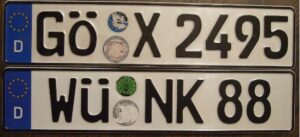Secure order and payment
16. 08. 2022
How To Get German Plates For Vehicle Import And Export
After moving to Germany and registering your vehicle, your license number will be printed on your German plates, bearing the official seal of the district where you registered.
Below are more details on how to go about the German vehicle registration process.
How Does The German Car Registration System Work?
Registering your imported car in Germany involves reserving an appointment at a vehicle registration centre in your district. Before going for the registration there are some documents you need to have, including;
- TÜV Certificate (Technical Inspection):
For an imported car to be driven on German roads, it needs to be examined at a government-approved centre, after which it will be given a certificate. These examinations routinely cost between €100 and €200.
- Valid ID:
You need to have a valid means of identification, such as your country’s passport.
- Proof of Car Insurance:
In Germany, car insurance is compulsory, and you can’t register your vehicle without it. You will need to present your 7-digit eVB number given by your insurance provider.
- Certificate of Conformity:
A European Certificate of Conformity (COC) shows that a vehicle complies with European traffic standards. While Certificates of Conformity are issued by the manufacturer, EUROCOC can help you order your COC and deliver it to you quickly.
- Registration Certificate:
Every German resident, whether a citizen or a foreigner is given a registration certificate that serves as proof of residence.
- Proof of Ownership
- Foreign Registration Certificate(for registering imported cars)
- 032031 Form (Bank Details)
For registering an imported car, you will need to pay a 10% import fee and a 19% import Value Added Tax. Your bank information is necessary during registration to complete tax payments.
Exportation
After buying a vehicle in Germany, you might want to export it to a non-EU country. For that, you will need to make a customs declaration via the ATLAS Export system.
If you intend to drive the vehicle out of Germany, you can make the customs declaration at the border through which you’ll exit the EU.
If the vehicle does not weigh more than 1000kg and does not cost more than €1000, the declaration can be made orally.
You also need to get German export plates for exportation.
How To Apply For German Number Plates?
After registering your vehicle, you can proceed to an Autoschilder branch or contact an online specialist to print out your plates.
Next, you should return to the registration office to get the official seal of your German district on the license plates.
How Much For Car Registration In Germany?
The price of vehicle registration in Germany is around €30 to €60, but other procedures also cost money. For instance, the technical inspection costs around €100 and €200, and you might spend between €15 to €50 to purchase German car number plates.
What Do German Car Number Plates Look Like?
German car number plates are coloured white, while the characters that represent the car’s registration number are black. Most German plates are made from aluminium.
In the majority of Europe, including Germany, the general size for car license plates is 520 mm x 110 mm (20.5 inches x 4.3 inches). Trucks, buses, and trailers also use this same license plate size.
To signify its EU membership, German registration plates display the EU flag on the left side as a blue strip decorated with 12 yellow stars forming a circle. The flag is accompanied by the letter ‘D’, the international vehicle registration code of Germany.
Format Of German Number Plates
The registration number on German plates is split into two components, and has a general format that resembles ‘AAA BBCCCC’.
- Area Code (AA)
The first part of a German car registration number is the area code that represents the German district where the car was registered. Depending on the code, it can either be one, two, or three characters.
To easily conduct a German number plate check, take a look at this complete list of German districts and their codes.
- Serial code (BBCCCC)
The second section is a serial code that consists of one or two letters (BB) and one, two, three, or four numbers (CCCC). The code ranges from A1 to ZZ9999.
The final feature of German plates is a pair of stickers – a registration sticker that validates the plate and a safety test sticker that signifies that a vehicle is roadworthy.
Front plates only have the registration sticker, while rear plates have both, with the safety sticker placed above the registration sticker. The sticker location is between the Area code and serial code.
What Types Of German License Plates Exist?
Special German plates are reserved for government officials, military vehicles, ambulances, and diplomatic vehicles.
For example, the President and Chancellor have license plate numbers of ‘0-1’ and ‘0-2’ respectively. Also, cars belonging to car dealers have red characters instead of the customary black.
German Custom Number Plates
You can customize the details that you want to be printed on your German registration plates, even though your choice is limited to just the 6-digit serial code at the end of the registration number.
You might need to pay an extra €10 to €15 for a reservation.












